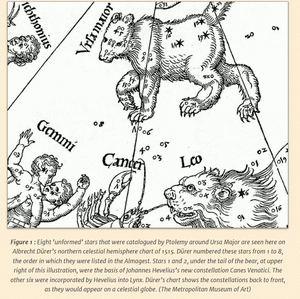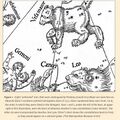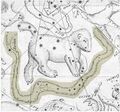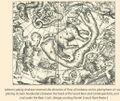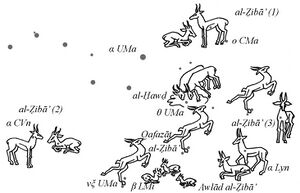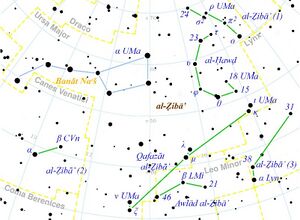Jordanus
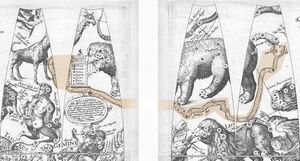
An obsolete Early Modern constellation made from eight unnamed Ptolemaic stars: Alpha and Beta CVn, Alpha, 31 and 38 Lyncis (according to Toomer), and three fainter stars of uncertain identity.
Etymology and History
It is the name of a (real) river with immense cultural significance, not only as a border between countries but also for several religions. The English word is a Latin loanword, derived from Semitic 'Yard|on' 'flow down' <√ירד reflecting the river's declivity (Hebrew: נְהַר הַיַּרְדֵּן, Nəhar hayYardēn, Arabic: نَهْر الْأُرْدُنّ, Nahr al-ʾUrdunn).
Constellation
The extinct constellation "Jordanus Fluvius" or "Jordanis" – the river Jordan – was invented by Petrus Plancius on his 1612 celestial globe.[1][2][3] The constellation first appeared in print in the book Usus Astronomicus Planisphaerii Stellati by Jacob Bartsch (1624), as his 26th constellation – "Iordanis" or "Iordanus". In the illustration of "Iordanis" on Bartsch's celestial globe Planisphaerium Stellatum... (1661), the star Alpha Lyncis appears as one of the prominent stars in the middle of the constellation. The extinct constellation also appeared as "Iordan" on Isaac Habrecht's (1628) Planiglobium coeleste et terrestre, "Fluvius Jordanis" in Carel Allard's (1708) Planisphaerii Coelestis Hemisphaerium Septentrionale and "Ior-Dan" in Corbinianus Thomas' (1730) Mercurii philosophici firmamentum firmianum. John Barentine (2016) notes that most of the area of Jordanis (and its aliases) was carved up in Hevelius's Lynx, Leo Minor, and Canes Venatici, which were subsequently adopted as constellations by the IAU in the 1920s.
Occurrence in historical maps and globes
- van den Keere, Pieter & Plancius, Petrus 1612, celestial globe.[4]
- Bartsch, Jacob, 1624, Usus Astronomicus Planisphaerii Stellati, p. 57.
- Habrecht, Isaac, 1628, Planiglobium coeleste et terrestre, Figura I.[5]
- Cellarius, Andreas, 1660, Harmonia Macrocosmica, Plates 24, 25 & 26.[6]
- Royer, Augustin, 1679, Cartes du ciel reduites en quatre tables.[7]
- Brunacci, Francesco, 1687, Planisfero del Globo Celeste Arctico & Antarctico.[8]
- Coronelli, Vincenzo, 1692, Planisfero Settentrionale, corretto, et accresciuto di molte Stelle,[9] also on his celestial globes dated 1693 & 1696.[10]
- Allard, Carel, 1708, Planisphaerii Coelestis Hemisphaerium Septentrionale.[11]
- Thomas, Corbinianus, 1730, Mercurii philosophici firmamentum firmianum, Frankfurt/Leipzig.
Transformation of Constellation
The eight 'external' stars south of Ursa Major in Dürer's star chart 1515, described by Ian Ridpath (highlighted by SMH).
Jordanus constellation (highlighted) in Habrecht, Isaak, Planiglobium coeleste ac terrestre (1666).
Image of the river with its direction of flow reversed by Johann Ludwig Andreae (1724) with description by Ian Ridpath
Mythology / Cultural Significance
The Jordan River. Modified from MAP Cross-checked with other maps, especially in the area of the Hula swamp and the tributaries (see Wikicommons).
Names of the Stars in Jordanus
al-Ẓibā’ in Paul Kunitzsch, Untersuchungen zur Sternnomenklatur, 1961.
* 21a. awlād aẓ-Ẓibā’, p. 39:
„die Jungen der Gazellen“. Ibn Qutayba 67, 1 (bei den unter Mondstation 14 mitbehandelten Sternen) : kawākib ṣiġār fī-mā bayna ẓ-ẓibā’ wa-l-qafazāt „kleine Sterne zwischen aẓ-ẓibā’ [nr. 329] und al-qafazāt [nr. 211a]“. Ṣūfī 34, 1f. und 18‒20 zählt besonders den 5. bis 8. externen Stern im ptolemäischen Bildes Großer Bär = Fl. 10 Leonis Minoris; IX, 115; VIII, 245; Fl. 31 Lyncis hierzu, sowie all die zahllosen Sterne, die schwächer sind als Größe sechs und die Prolemäus nicht angeführt habe.
'English: the young of the gazelles’. Ibn Qutayba 67, 1 (for the stars treated under lunar station 14): kawākib ṣiġār fī-mā bayna ẓ-ẓibā‘ wa-l-qafazāt “small stars between aẓ-ẓibā” [no. 329] and al-qafazāt [no. 211a]’. Ṣūfī 34, 1f. and 18-20 counts especially the 5th to 8th external star in the Ptolemaic image Great Bear = Fl. 10 Leonis Minoris; IX, 115; VIII, 245; Fl. 31 Lyncis, as well as all the countless stars that are fainter than magnitude six and that Prolemy did not mention.
* 329. aẓ-Ẓibā’, p. 120:
„die Gazellen“. Ibn Qutayba 66, 11 (bei den unter Mondstation 14 mitbehandelten Sternen): kawākib mustaṭīla asfal min qafazāt aẓ-ẓibā’ „der Länge nach angeordnete Sterne unterhalb von qafazāt aẓ-ẓibā’ [= ικλμνξ Ursa Majoris]“; Ṣūfī 33,7 identifiziert aẓ-ẓibā’ mit den Sternen auf Brauen, Augen, Ohren und Maul des ptolemäischen Bildes Großer Bär (d. h. der 4., 5., 2., 3., 6. Und 1. Stern) = ρο2Aπ2σ2dο Ursae Majoris, wozu er 33, 19‒34, 2 noch den 8., 3., und 4. Externen des Großen Bären = Fl. 31, 40 (α), 38 Luncis hinzunimmt. Nur dies Lteztezrebn drei Stimmen mit der anwā’ Definition „unterhalb von qafazāt aẓ-ẓibā’” überein.
English: ‘the gazelles’. Ibn Qutayba 66, 11 (for the stars treated under lunar station 14): kawākib mustaṭīla asfal min qafazāt aẓ-ẓibā‘ “stars arranged lengthwise below qafazāt aẓ-ẓibā” [= ικλμνξ Ursa Majoris]’; Ṣūfī 33,7 identifies aẓ-ẓibā with the stars on the brows, eyes, ears and mouth of the Ptolemaic image Great Bear (i.e. the 4th, 5th, 2nd, 3rd, 6th and 1st stars). i.e. the 4th, 5th, 2nd, 3rd, 6th and 1st star) = ρο2Aπ2σ2dο Ursae Majoris, to which he adds 33, 19-34, 2 the 8th, 3rd and 4th exterior of the Great Bear = Fl. 31, 40 (α), 38 Luncis. Only these three Lteztezrebn agree with the anwā‘ definition “below qafazāt aẓ-ẓibā”’.
al-Ẓibā’ in Roland Laffitte, Le ciel des Arabes, p. 112-113.
|
ο2ρπ2σ2d UMa +αβ CVn + α/31 Lyn | ||||
| al-Ẓibā’ | les Gazelles | the Gazelles | Qutayba | |
| Lyn | Ğanūbī ’l-Ḍibā’ [p/ al-Ẓibā’] | l’Australe des Gazelles | the southern one of the Gazelles | Miṣrī |
| 31 Lyn | Mutaq. al-Ḍibā’ [p/ al-Ẓibā’] | l’Antérieure des Gazelles | the front one of the Gazelles | Miṣrī |
| 38 Lyn | Šamālī ’l-Ḍibā’
[en fait : al-Ẓibā’] |
la Boréale des Hyènes
[en fait : les Gazelles] |
the northern one of of the Hyena | Miṣrī |
| 46, 21+β LMi | ||||
| Awlād al-Ẓibā’ | les Petits des Gazelles | the small one of the Gazelles | Qutayba | |
| Awlād al-Ġizlān | idem | Ṣūfī | ||
| τhυφθef UMa | ||||
| al-Ḥawḍ | l’Abreuvoir | the Water Trough | Qutayba | |
| al-ᶜUnq | l’Assemblée | the Meeting | Qutayba | |
| ικλμνξ UMa | ||||
| Qafazāt al-Ẓibā’ | les Sauts | Qutayba | ||
| al-Qafazāt | les Sauts [des Gazelles] | Qutayba | ||
| Qafazāt al-Ġizlān | les Sauts des Gazelles | Ṣūfī | ||
| al-Qawāfiz | les Bondissantes | Marzūqī | ||
| Baqarāt al-Ẓibā’ | les Gazelles femelles | Fāris | ||
| νξ UMa | al-Qafazat al-Ūlā | le 1er Saut | Ṣūfī | |
| λμ UMa | al-Qafazat al-Ṯāniyya | le 2nd Saut | Ṣūfī | |
| ικ UMa | al-Qafazat al-Ṯāliṯa | le 3ème Saut | Ṣūfī | |
| ι UMa | Šamālī ’l-Qafazat al-Ūlā
[en fait : al-Ṯāliṯa] |
la Boréale du 1er Saut
[en fait : le 3ème] |
Miṣrī | |
| κ UMa | Ğanūbī ’l-Qafazat al-Ūlā
[en fait : al-Ṯāliṯa] |
l’Australe du Premier Saut
[en fait : le 3ème] |
Miṣrī | |
| λ UMa | [Šamālī] ’l-Q. al-Ṯāniyya | [la Boréale] du 2nd Saut | Miṣrī | |
| μ UMa | Ğanūbī ’l-Q al-Ṯāniyya | l’Australe du 2nd Saut | Miṣrī | |
| ξ UMa | Ğanūbī ’l-Q. al-Ṯāliṯa
[en fait : al- Ūlā] |
l’Australe du 3ème Saut
[en fait le 1er] |
Miṣrī | |
NB : Miṣrī is Nağm al-Dīn al- Miṣrī (XIVth c.), see Ğadwal maṭāliᶜ al-kawākib wa-abᶜādihā wa-ğihatihi, soit « Table des ascensions droites des étoiles et de leurs déclinaisons accompagnées de leurs signes [+ ou ‒], est l’un des tables figurant dans le Kitāb fī l-ālāt al-falakiyya de Nağm al-Dīn al-Miṣrī, entre 1325 et 1340. Elle vient d’être éditée et traduite à partir du ms. Oxford, Bodeliean Library, Marsh 672, fol. 148v-151r, in CHARRETTE, François, Mathematical Intrumentation in Fourteenth-Century Egypt and SyriaB►, 2003, p. 360-370.
IAU Working Group Star Names
The name was suggested to the IAU WGSN to be used as a star name in 2023. Alpha and Beta CVn are already named (Cor Caroli and Chara), the brightest of the others is Alpha Lyncis (SIMBAD: 3.1 mag in V). For this star, also the star name "Xuanyuan" was suggested but rejected because of the tremendous significance of this Chinese term for the Chinese cultural heritage.
In the earliest versions of the drawing of the Jordanus River, the headwaters of the river are marked by three stars, likely to be identified with 25 CVn and 20 CVn + HR 4997. Their names on late 16th-century Dutch biblical maps[12] are Dan and Ior.[13] Thus, it is proposed to name one, two or all three stars within the obsolete constellation:
- α Lyncis: "Jordanus", (SIMBAD: 3.1 mag in V)
- 25 CVn: "Ior" (SIMBAD 4.82 mag) for the sake of symmetry, perhaps also BH CVn (SIMBAD 4.94-5.1 mag VSX), but on some maps explicitly only one star here
- 20 CVn + HR 4997: "Dan" (SIMBAD 4.69 mag, SIMBAD 4.94 mag)
The above list of historical names confirms, that there are no Arabic names competing for the stars are suggested to call Ior and Dan.
The WGSN chose ... (not to apply/ to apply the name to a neighbouring star/ to ...) in the IAU-CSN.
Weblinks
Reference
- ↑ Ridpath, Ian, "Star Tales: online edition".
- ↑ Barentine, John C., 2015, The Lost Constellations: A History of Obsolete, Extinct, or Forgotten Star Lore, Springer Praxis Books LINK, Chichester, UK, p. 201-216.
- ↑ Harper, David & Stockman, L.M., 2020, "Jordanus Fluvius – The River Jordan",
- ↑ Rijksmuseum link.
- ↑ ECHO link.
- ↑ Alvin link 1, Alvin link 2, Alvin link 3.
- ↑ Gallica link 1, Gallica link 2.
- ↑ Gallica link.
- ↑ Gallica link 1, Gallica link 2.
- ↑ Gallica link 1, Gallica link 2.
- ↑ Rijksmuseum link.
- ↑ In 1590 Petrus Plancius designed a set of biblical maps, engraved by Johannes van Deutecom and his sons Baptista and Johannes, to illustrate a new edition of the so-called Deux-Aes Bible printed by the Amsterdam publisher Laurens Jacobszoon. The map of the Holy Land in this set distinctly marks the headwaters of the Jordan River as Dan fons and Ior fons. Later editions of these maps were embellished by adding a border with biblical scenes. See example 1, example 2.
- ↑ The names Ior and Dan as the headwaters of the Jordan River appear to have originated in European pilgrim narratives and chronicles in the times of the Crusades. Cf. George Adam Smith, The Historical Geography of the Holy Land, Especially in Relation to the History of Israel and of the Early Church (New York: A.C. Armstrong and Son, 1895), p. 472 [note 1] [Internet Archive link].


